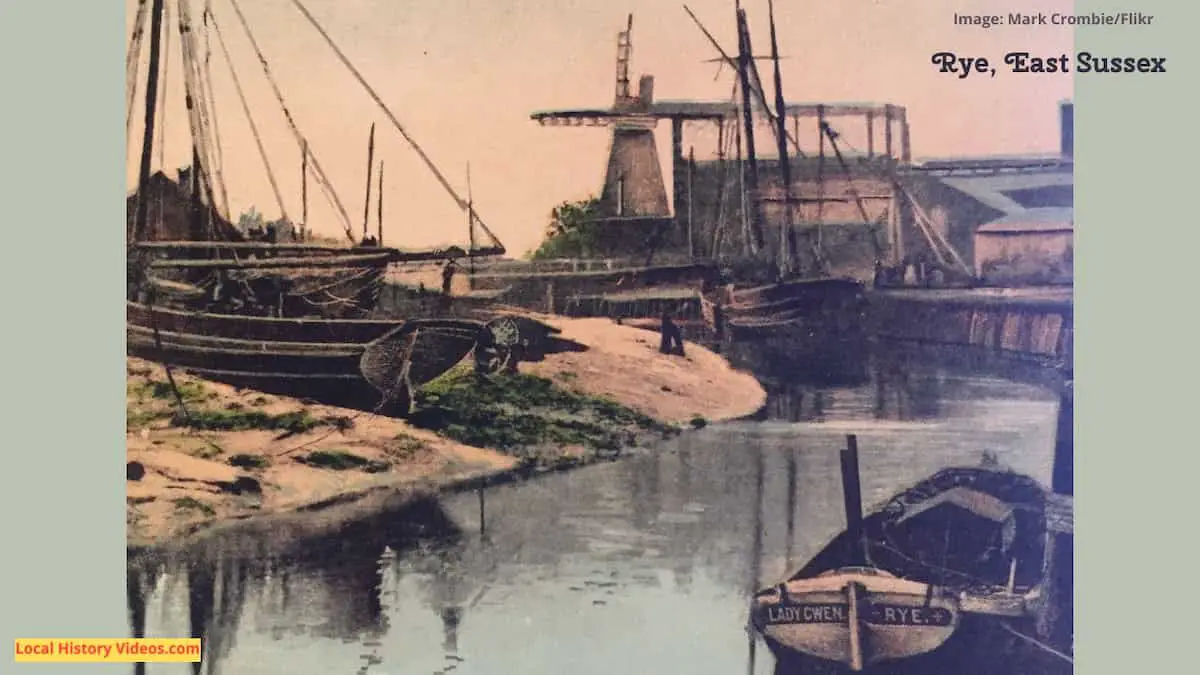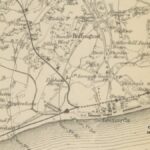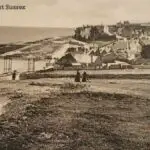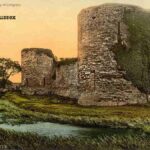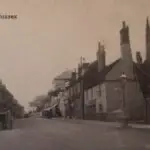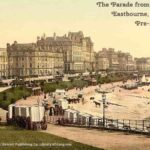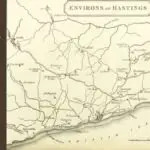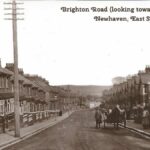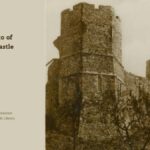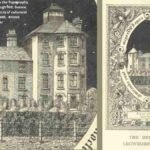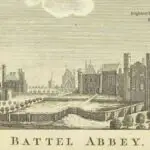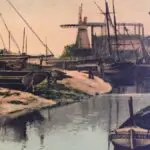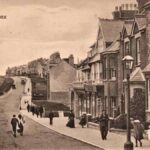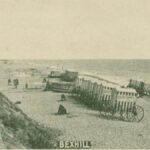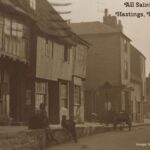Glimpse history through old images of Rye, East Sussex, England.
Admiral Sir Beatty 1920
Footage shows the visit of Admiral Sir Beatty 1920, as he was made a freeman of the town of Rye.
Admiral of the Fleet David Beatty, 1st Earl Beatty, was a Royal Navy admiral and hero of the famous World War I naval battle of Jutland.
Admiral Sir Beatty at Rye (1920) – British Pathé on YouTube
Lifeboat Crew Funeral 1928
At 5 a.m. on 15th November 1928, in rough seas near Dungeness, the small Latvian vessel Alice sent up a maroon flare, seeking help.
Rye’s lifeboat crew ran to their lifeboat the Mary Stanford, but low tide meant they had problems getting her launched, causing them all to board in cold, soaking wet clothing.
Despite still being close to shore, their difficulties in setting the sails in bad weather meant they missed the recall flare telling them their services were no longer needed.
All 17 men on board died when the lifeboat capsized.
The Reverend Harry Newton knelt on the beach to pray, accompanied by the women of the village, as they waited for the lost men to be found and brought to shore.
The crew of the Mary Stanford:
Coxswain Herbert Head (47)
Second Coxswain Joseph Stonham (43)
Bowman Henry Cutting (39)
Leslie Clark (24)
William Clark (27)
Albert Ernest Cutting (26)
Robert Redvers Cutting (28)
Arthur Downey (25)
Maurice James Downey (23)
James Head (19)
John Head (17)
Walter Igglesden (38)
Charles Frederick David Pope (28)
Alexander Pope (21)
Robert Henry Pope (23)
Herbert Smith (44)
Charles Southerden (22)
On the day of the funeral, more than 1,000 wreaths were laid.
You can find more information and photographs about this terrible event on the RNLI website.
The first footage includes a recreation of the work the lifeboat men did, using oars to get to distressed ships in that era.
WEATHER: Gale scenes at Rye (1928) – British Pathé on YouTube
The next four items focus on the mass funeral held for the lost lifeboat crew, some of them still teenagers.
DISASTERS: Funeral of Lifeboat victims at Rye (1928) – British Pathé on YouTube
Their Duty Nobly Done Aka Their Duty Nobley Done (1928) – British Pathé on YouTube
Toll For The Brave (1928) – British Pathé on YouTube
Funeral scenes after lifeboat disaster at Rye (1928) – British Pathé on YouTube
3rd Anniversary 1931
The death of the lifeboat men had a profound impact on the local community. On the third anniversary of their deaths, a memorial was unveiled.
Rye Lifeboat Disaster: memorial unveiled (1931) – British Pathé on YouTube
“We Have Done That Which Was Our Duty To Do!” (1931) – British Pathé on YouTube
Gold Tournament 1938
The Oxford and Cambridge Golfing Society’s Annual Tournament for the President’s Putter on a golf course at Rye was filmed in 1938.
President’s Putter Trophy At Rye (1938) – British Pathé on YouTube
Bonfire Night 1946
Black and white footage shows us how Bonfire Night, also known as Guy Fawkes Night, was enjoyed on 5th November 1946.
November 5th (1946) – British Pathé on YouTube
Rye Carnival 1963
Children enjoyed a range of dressing up actvities and entertainment in 1963.
Children’s Carnival (1963) – British Pathé on YouTube
Rye’s 1963 night time Carnival and fair was captured on film, showing us a range of activities enjoyed that night.
Night Carnival Aka Carnival At Night (1963) – British Pathé on YouTube
1970s Rye
This silent 1970s footage starts with Calais, then moves at 3:18 to the historic buildings of Rye, including the Mermaid Inn, rebuilt in 1420.
When I’ve added the embedded film, I’ve set it to start at 3:18 so hopefully this will start to play for you from the scene with the cafe’s blue awning. Later scenes show Southampton.
Rye And Southampton And Calais (1970-1979) – British Pathé on YouTube
A Bit of Rye History
Extract from: “The” National Gazetteer – A Topographical Dictionary of the British Islands ; Compiled from the Latest and Best Sources, and Illustrated with a Complete County Atlas, and Numerous Maps. Naas to Zouch Mill · Volume 3
Published in 1868
Page 377 & 378
RYE , & par . , cinque port , post and market town ,
parliamentary and municipal borough , locally in the
hunds of Goldspar and Gostrow , rape of Hastings , co .
Sussex , but exercising separate jurisdiction , 9 miles N.E.
of Hastings , and 63 B.E. of London by road , or 81 by
the South – Eastern line of railway . A branch line of
railway called the Rye Harbour line has been opened to
Hastings chiefly for goods traffic . It is situated near
the Military canal and the navigable river Rother ,
which has been improved by cutting a new channel so
as to permit vessels not exceeding 200 tons burden to
approach the quay . It is supposed to have been the
Roman Portus Novus , and was the place where the
Danes landed in 893. At the Norman conquest it was
given by Edward the Confessor to Fiscump Abbey
in France , and was first chartered by Richard 1 .
Henry III . annexed it with Winchelsea to the Cinque
Ports , and in the reign of Edward III . it was surrounded
by a strong wall with several gates , of which that called
the North or Land Gate , the only one remaining ,
now forms an entrance to the town from the London and
Dover roads . There are also on the S. side of the town
remains of a strong castle or tower , erooted in the 12th
century by William de Ypres , Earl of Kent , and now
forming part of the gaol . About the same period the course
of the river Hother was diverted this way through an
inundation of the sea , which greatly improved the
natural harbour , so that the town soon became 80
considerable a port that it was able to furnish nine
ships towards the royal fleet for the siege of Calais .
The town was twice burnt by the French , in 1377 and
again in 1447 , from which it scarcely recovered till the
reign of Elizabeth , who bestowed on it several additional
privileges , and was entertained by the corporation in 1573.
The trade done is chiefly in corn , coal , timber ,
hopa , oak – bark , and wool , this last being largely ox
ported to France . Ship – building is also extensively
carried on , and mackerel in immense quantities are
caught here in kettle nets erected on the sea shore near
Rye Harbour , during the summer season . The Rye
Harbour line of railway , opened in 1851 , does immense
traffic in oual , which is landed here to be forwarded to
Hastings . Extensive works have recently been estab
lished by Lee & Sons for the manufacture of concrete
blocks , each weighing eight or ten tons , and formed out
of shingle and cement , to be used in the construction of
the Admiralty pier at Dover . The town , which is
ancient , and has many interesting historical reminis
cences , consists of several regular and well – formed
streets . It is built upon a hill , the sides of which
towards the 8. and S.W. are rocky and precipitous , but
alope down gradually on the land side , beyond which a
range of hills rises aheltering the town on the N. and
N.W. , while the river Rother skirta it on the E. , and
the united streams of the Brede and Tillingham forming
a branch of the Rother on the S.W. It is well paved ,
lighted with gne , and supplied with water from a
reservoir under Playden heights . The townhall and
market house is built on pillars in the centre of the
town , the upper story being used for the borough
sessions , and the area for the market , now fallon
into disuse . The other public buildings include the
customhouse , a theatre , union poorhouse , three bridges ,
& theatre , savings – bank , two commercial branch banks ,
a gaol , police station , gas works , mechanics ‘ institute ,
and a literary and scientille institution established
in 1899. Its government , anciently styled the ” mayor ,
jurats , and commonalty , of the ancient town of Rye , “
is vested , under the new Manicipal Reform Act , in
a mayor , four aldermen , and 12 councillors , and a
commission of the peace has also been granted , can
sisting of six magistrates appointed by the crown . The
mayor acts as returning officer . The borough revenue
is about £ 1,000 . Prior to the Reform Act Ryo returned
two members to parliament from the reign of Henry
III .; it now returns but one for the extended bounds ,
including Udimore , East Guildeford , Icklesham , Iden ,
Peasmarsh , Playden , Winchelsen , and part of Brede .
The parliamentary borough is the most extensive , con
taining ( in 1861 ) 8,202 inhabitants , while the municipal
borough contains only , 3,738 , and the parish of kye
4,288 . Many of the inhabitants are engaged on the
coasting trade and the fisheries , and some in lodging
letting , the various improvements made in the town and
its approaches , together with the natural advantages of
its situation , having latterly caused it to be resorted to
as a watering – place . – An embankment has been con
structed along the sides of the harbour , the marshes in
the neighbourhood , formerly covered by the tide ,
drained , and a new tidal harbour formed at the mouth
of the river to the S.W. of the town , though even this is
partially impeded by the accumulation of sand and
shingle , which choked the old one . The depth of water
in the harbour is about 14 feet , the tide rising from 12
to 17 feet , and beyond is West Bay , with from two to
four fathoms . A wooden pier runs out to a considerable
distance , and is thence continued by a stone wall stretching
out over the flats . There are two lighthouses respec
tively 36 and 26 feet above sea – level , and visible for
about 10 miles . Much of the land in the vicinity of
Ryo is in hop – grounds . – Rye is a polling – place for East
Sussex , and the scat of a Poor – law Union comprising
twelvo parishes , the union workhouse being situated at
Ryo Hill , where the board of guardians hold their
meetings . It is also the head of superintendent registry
and new County Court districts . Petty sessions for the
division are held here by the county magistrates on
Wednesdays , and the borough justices hold sessions every
Monday and Thursday . The living is a vie . in the
dioc of Chichester , val . 410. The church , dedicated to
St. Mary , is an ancient cruciform structure with an
embattled tower and a clock on the N. face of it said to
be the oldest in England . The interior of the church con
tains some ancient brasses . The register dates from 1638 .
The parochial charities produce about £ 171 per annum ,
besides two almshouses for widows . There are National
schools for both sexes , also Peacock’s free grammar
school , in which the art of navigation is taught . At
the harbour mouth is a church designated the Church of
the Holy Spirit , and frequented chiefly by the coast
guard and their families . There are places of worship
for the Independents and Baptists . – On the London
road are tracos of the town walls , also of an Austin friary
founded prior to Edward III.’s time , now used as a
storehouse . Market days are Wednesdays and Satur
days . A fair is hold on the 10th August .
More about East Sussex
- Old Images of Wannock, East Sussex
- Old Images of St Leonards-on-Sea, East Sussex
- Old Images of Crowhurst, East Sussex
- Old Images of Rottingdean, East Sussex
- Old Images of Pevensey, East Sussex
- Old Images of Hailsham, East Sussex
- Old Images of East Sussex, England
- Old Images of Winchelsea, East Sussex
- Old Images of Newhaven, East Sussex
- Old Images of Lewes, East Sussex
- Old Images of Crowborough, East Sussex
- Old Images of Battle, East Sussex
- Old Images of the Pestalozzi Children’s Village, Sedlescomb
- Old Images of Rye, East Sussex
- Old Images of Seaford, East Sussex
- Old Images of Sidley Green, East Sussex
- Old Images of Bexhill-on-Sea, East Sussex
- Old Images of Hastings, East Sussex
- Old Images of Eastbourne, East Sussex

